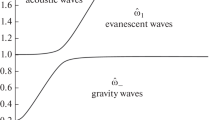Abstract
Because of its geophysical interpretation, Earth’s polar motion excitation is generally decomposed into prograde (counter-clockwise) and retrograde (clockwise) circular terms at fixed frequency. Yet, these later are commonly considered as specific to the frequency and to the underlying geophysical process, and no study has raised the possibility that they could share features independent from frequency. Complex Fourier Transform permits to determine retrograde and prograde circular terms of the observed excitation and of its atmospheric, oceanic and hydrological counterparts. The total prograde and retrograde parts of these excitations are reconstructed in time domain. Then, complex linear correlation between retrograde and conjugate prograde parts is observed for both the geodetic excitation and the matter term of the hydro-atmospheric excitation. In frequency domain, the ratio of the retrograde circular terms with their corresponding conjugate prograde terms favours specific values: the amplitude ratio follows a probabilistic gamma distribution centred around 1.5 (maximum for 1), and the argument ratio obeys a distribution close to a normal law centred around \(2 \alpha = 160^{\circ }\). These frequency and time domain characteristics mean an elliptical polarisation towards \(\alpha ={\sim } 80^{\circ }\) East with an ellipticity of 0.8, mostly resulting from the matter term of the hydro-atmospheric excitation. Whatsoever the frequency band above 0.4 cpd, the hydro-atmospheric matter term tends to be maximal in the geographic areas surrounding the great meridian circle of longitude \({\sim }80^{\circ }\) or \({\sim } 260^{\circ }\) East. The favoured retrograde/prograde amplitude ratio around 1.5 or equivalently the ellipticity of 0.8 can result from the amplification of pressure waves propagating towards the west by the normal atmospheric mode \(\Psi _3^1\) around 10 days.




Similar content being viewed by others
References
Barnes RTH, Hide R, White AA, Wilson CA (1983) Atmospheric angular momentum fluctuations, length-of-day changes and polar motion. Proc R Soc Lond A 387:31–73
Bizouard C (2014) Le mouvement du pôle de l’heure au siècle. Presses Académiques Francophones, p 284
Bizouard C, Gambis D (2008) The combined solution C04 for Earth Orientation Parameters, recent improvements. In: Drewes H (ed) Series International Association of Geodesy Symposia 134. Springer Verlag series, p 330. ISBN: 978-3-642-00859-7
Brzeziński A (1994) Polar motion excitation by variations of the effective angular momentum function, II: extended model. Manuscr Geod 19:157–171
Brzeziński A, Bizouard C, Petrov S (2002) Influence of the atmosphere on Earth rotation: what new can be learnt from the recent atmospheric angular momentum estimates? Surv Geophys 23:33–69
Lambeck K (1980) The Earth’s variable rotation : geophysical causes and consequences. Cambridge University Press
Munk WH, Mac Donald G (1960) The rotation of the Earth. Cambridge University Press, Cambridge
Nastula J, Salstein D, Kolaczek B (2009) Patterns of atmospheric excitation functions of polar motion from high resolution regional sectors. J Geophys Res 114:B04407. doi:10.1029/2008JB005605
Nastula J, Salstein D, Gross R (2014) Regional Multi-fluid-based geophysical. excitation of polar motion. In: Rizos C, Willis P (eds) Earth on the edge: science for a sustainable planet. International Association of Geodesy Symposia 139. Springer-Verlag, Berlin, Heidelberg (2014). doi:10.1007/978-3-642-37222-3-62
SBA (2015) Website of the IERS Special bureau for the atmosphere. http://ftp.aer.com/pub/anon_collaborations/sba/
SBH (2015) WEB site of the IERS special bureau for hydrology. http://geophy.uni.lu/ggfc-hydrology.html
SBO (2015) WEB site of the IERS special bureau for the oceans. http://geophy.uni.lu/ggfc-oceans.html
Sidorenkov N (2009) The interaction between Earth’s rotation and geophysical processes, Wiley-VCH Verlag GmbH&Co., Chapter 6, p 113–118. ISBN 978-3-527-40875-7
Vondrák J (1977) Problem of smoothing observational data II. Bull Astron Inst Czech 28:84–89
Wilson C (1985) Discrete polar motion equation. Geophys J R Astron Soc 80(2):551–554
Zotov L, Bizouard C (2012) On modulations of the Chandler wobble excitation. J Geodyn. doi:10.1016/j.jog.2012.03.010
Zotov L, Bizouard C (2014) Regional atmospheric influence on the Chandler wobble. Adv Space Res. Elsevier. doi:10.1016/j.asr.2014.12.013
Acknowledgments
We are grateful to our three reviewers for their careful analysis, which permitted to improve the quality of this study. We are especially indebted to Leonid Zotov for having carried out some computational check.
Author information
Authors and Affiliations
Corresponding author
Rights and permissions
About this article
Cite this article
Bizouard, C. Elliptic polarisation of the polar motion excitation. J Geod 90, 179–188 (2016). https://doi.org/10.1007/s00190-015-0864-7
Received:
Accepted:
Published:
Issue Date:
DOI: https://doi.org/10.1007/s00190-015-0864-7




